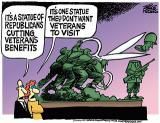PTSD is not only something that develops in soldiers in War and Occupations. It develops in those who live in these theaters of death, destruction and occupation. It develops in civilians all over, from children to adults, who survive through any number of extreme trauma's in their individual lives, suffered in silence and triggered by many means! But the 24/7 stress of occupation combat theaters, for soldier and civilian, that which each may see, do or know about, bring memories the complete opposite of what we're taught that life and living is, that can't just be wiped out of ones mind nor can one be brought back to a time before those experiences, they are forever there!
The effects of post-traumatic stress disorder (PTSD) are just beginning to be understood. During my time at Walter Reed Army Medical Center, I noticed that those with visible wounds were treated as rock stars while those with invisible wounds silently carried on without the attention the others received. These Soldiers kept trying to be the Soldier they once were pre-deployment. I found out the hard way that there is no prosthetic for invisible wounds like PTSD.
December 27th, 2010 - Diana Hume offers resources to help others understand the impact of living with PTSD.
PTSD is complex because it doesn’t take the form of a body disfigurement or a lost limb. I see my husband walking, talking, and trying to function every day. But for those who live with him, they are well aware that he’s actually taking on the weight of the universe. The pain is visible in his face, his motions, and self-controlled isolation.
Part of me feels that PTSD comes off as a buzz term in news segments. I wonder how many people actually know about the condition. How many Americans can say they understand PTSD? More importantly how many people understand what PTSD means to not just Soldiers but for their caretakers and Families? {continued}























No comments:
Post a Comment